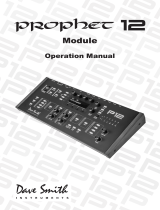
A Few Words of Thanks
Thank you for purchasing the Prophet-6. We take a lot of pleasure in creating all
of our instruments but bringing the Prophet-6 to life was particularly satisfying.
In many ways it brings my 40-plus years of designing synthesizers full circle. I’ll
tell you why.
In 2014, two events occurred that led to the creation of the Prophet-6. The rst
was a fairly common one around our ofce — our usual informal discussion
about what would be interesting to build next. (We don’t do marketing surveys
around here.) We all agreed that an analog poly synth with true voltage-controlled
oscillators, lters, and ampliers would not only be exciting to design, but would
also almost certainly sound great. So we decided to do it.
Event two transpired when, unknown to me, my old friend and collaborator in the
creation of MIDI, Ikutaro Kakehashi, founder of Roland, asked Yamaha Corporation
to consider returning ownership of my original company brand, Sequential Circuits,
to me. (Yamaha had purchased Sequential’s assets when we closed shop back in
1987.) Yamaha generously agreed and suddenly Sequential was back — almost. All
we needed was an awesome new product to bear the name.
Well, you know how the story ends: with the very synth you’ve just purchased. We
gured that building the best-sounding analog poly synth possible would be a tting
tribute to Sequential’s most famous instrument, the Prophet-5, the poly synth that
started it all.
The Sequential Prophet-6 takes the best qualities of the Prophet-5 and adds some nice
touches that the original never had, such as stereo outputs, velocity and aftertouch
sensitivity, dual digital effects, a high-pass lter, a polyphonic step sequencer, an
arpeggiator, and of course, MIDI. The result is a synth with vintage analog tone and
the reliability of a state-of-the-art, modern instrument.
I hope you enjoy the Prophet-6 as much as we enjoyed designing it.
Cheers,






















